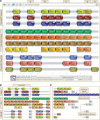The Yeast Gene Order Browser: combining curated homology and syntenic context reveals gene fate in polyploid species
- PMID: 16169922
- PMCID: PMC1240090
- DOI: 10.1101/gr.3672305
The Yeast Gene Order Browser: combining curated homology and syntenic context reveals gene fate in polyploid species
Abstract
We developed the Yeast Gene Order Browser (YGOB; http://wolfe.gen.tcd.ie/ygob) to facilitate visual comparisons and computational analysis of synteny relationships in yeasts. The data presented in YGOB, currently covering seven species, are based on sets of homologous genes that have been intensively manually curated based on both sequence similarity and genomic context (synteny). We reconciled different laboratories' lists of paralogous Saccharomyces cerevisiae gene pairs formed by genome duplication (ohnologs), and present near-exhaustive lists of the ohnolog pairs retained in S. cerevisiae (551, including 22 previously unidentified), Saccharomyces castellii (599), and Candida glabrata (404).
Figures



Similar articles
-
Visualizing syntenic relationships among the hemiascomycetes with the Yeast Gene Order Browser.Nucleic Acids Res. 2006 Jan 1;34(Database issue):D452-5. doi: 10.1093/nar/gkj041. Nucleic Acids Res. 2006. PMID: 16381909 Free PMC article.
-
A pipeline for automated annotation of yeast genome sequences by a conserved-synteny approach.BMC Bioinformatics. 2012 Sep 17;13:237. doi: 10.1186/1471-2105-13-237. BMC Bioinformatics. 2012. PMID: 22984983 Free PMC article.
-
Multiple rounds of speciation associated with reciprocal gene loss in polyploid yeasts.Nature. 2006 Mar 16;440(7082):341-5. doi: 10.1038/nature04562. Nature. 2006. PMID: 16541074
-
Evolutionary genomics: yeasts accelerate beyond BLAST.Curr Biol. 2004 May 25;14(10):R392-4. doi: 10.1016/j.cub.2004.05.015. Curr Biol. 2004. PMID: 15186766 Review.
-
Transcriptional regulators of seven yeast species: comparative genome analysis. Review.Folia Microbiol (Praha). 2008;53(4):275-87. doi: 10.1007/s12223-008-0044-8. Epub 2008 Aug 31. Folia Microbiol (Praha). 2008. PMID: 18759110 Review.
Cited by
-
Alternative sulphur metabolism in the fungal pathogen Candida parapsilosis.Nat Commun. 2024 Oct 24;15(1):9190. doi: 10.1038/s41467-024-53442-8. Nat Commun. 2024. PMID: 39448588 Free PMC article.
-
Integrated omics of Saccharomyces cerevisiae CENPK2-1C reveals pleiotropic drug resistance and lipidomic adaptations to cannabidiol.NPJ Syst Biol Appl. 2024 May 31;10(1):63. doi: 10.1038/s41540-024-00382-0. NPJ Syst Biol Appl. 2024. PMID: 38821949 Free PMC article.
-
An adaptive biomolecular condensation response is conserved across environmentally divergent species.Nat Commun. 2024 Apr 11;15(1):3127. doi: 10.1038/s41467-024-47355-9. Nat Commun. 2024. PMID: 38605014 Free PMC article.
-
N-terminal signals in the SNX-BAR paralogs Vps5 and Vin1 guide endosomal coat complex formation.Mol Biol Cell. 2024 Jun 1;35(6):ar76. doi: 10.1091/mbc.E24-01-0043. Epub 2024 Apr 10. Mol Biol Cell. 2024. PMID: 38598303 Free PMC article.
-
Absence of chromosome axis protein recruitment prevents meiotic recombination chromosome-wide in the budding yeast Lachancea kluyveri.Proc Natl Acad Sci U S A. 2024 Mar 19;121(12):e2312820121. doi: 10.1073/pnas.2312820121. Epub 2024 Mar 13. Proc Natl Acad Sci U S A. 2024. PMID: 38478689 Free PMC article.
References
-
- Cliften, P., Sudarsanam, P., Desikan, A., Fulton, L., Fulton, B., Majors, J., Waterston, R., Cohen, B.A., and Johnston, M. 2003. Finding functional features in Saccharomyces genomes by phylogenetic footprinting. Science 301: 71-76. - PubMed
-
- Dietrich, F.S., Voegeli, S., Brachat, S., Lerch, A., Gates, K., Steiner, S., Mohr, C., Pohlmann, R., Luedi, P., Choi, S., et al. 2004. The Ashbya gossypii genome as a tool for mapping the ancient Saccharomyces cerevisiae genome. Science 304: 304-307. - PubMed
-
- Dujon, B., Sherman, D., Fischer, G., Durrens, P., Casaregola, S., Lafontaine, I., De Montigny, J., Marck, C., Neuveglise, C., Talla, E., et al. 2004. Genome evolution in yeasts. Nature 430: 35-44. - PubMed
-
- Fischer, G., Neuveglise, C., Durrens, P., Gaillardin, C., and Dujon, B. 2001. Evolution of gene order in the genomes of two related yeast species. Genome Res. 11: 2009-2019. - PubMed
-
- Gao, L.Z. and Innan, H. 2004. Very low gene duplication rate in the yeast genome. Science 306: 1367-1370. - PubMed
WEB SITE REFERENCES
-
- http://wolfe.gen.tcd.ie/ygob; Yeast Gene Order Browser (YGOB)
Publication types
MeSH terms
LinkOut - more resources
Full Text Sources
Other Literature Sources
Molecular Biology Databases

